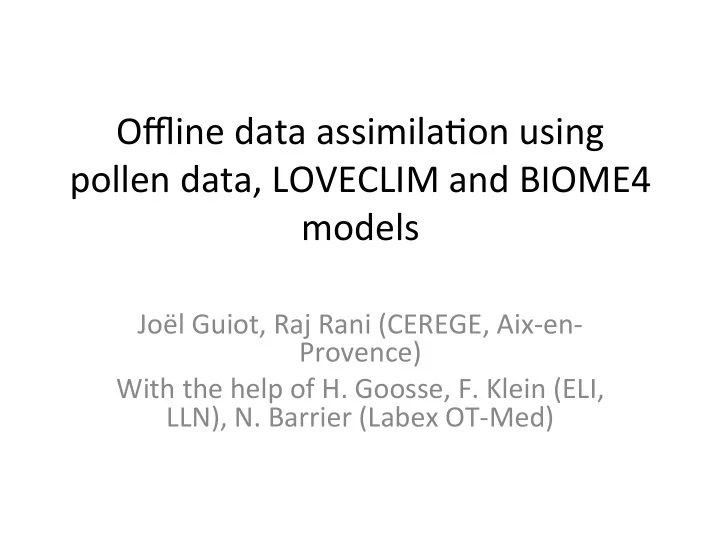

Offline data assimila-on using pollen data, LOVECLIM and BIOME4 models Joël Guiot, Raj Rani (CEREGE, Aix-en- Provence) With the help of H. Goosse, F. Klein (ELI, LLN), N. Barrier (Labex OT-Med)
Objec-ves and method • Using pollen data, climate model and vegeta-on model • Propose a new reconstruc-on of climate for the Holocene in the Mediterranean region • Taking into account the « reality » of the data and the physical coherency of the models • by off-line paleodata assimila-on based on fast climate + vegeta-on models • Proxy model used in a forward mode
Data and method • Pollen data from European Pollen Data (286 sites), pollen types converted into Plant func-onal types (PFT) • CRU climatology resolu-on 10’ • Intermediate complexity climate model: LOVECLIM 1.3 (Renssen et al 2005) – Atmosphere: ECBILT (Opsteegh et al, 1998) – Ocean sea ice: CLIO (Goosse and Fichefet, 1999) – Vegeta-on: VECODE (Brovkin et al, 2002)
Diagram of the method Assimila-on (par-cle filter) Inversion (MCMC) Uninforma-ve prior Proxy model BIOME4 pollen pollen Canonical analysis MCMC
The forcings a b c d Time-series of forcings: (a) total solar irradiance (w/m 2 ) Steinhilber et al. (2012) (b) CO 2 (ppmv) (c) CH 4 (ppbv) (d) N 2 O (ppbv), used in the Holocene experiment from ice cores for the Holocene (Indermuhle et al 1999) Completed by Muscheler et al (2007) for the last 1200 yrs Volcanism not considered
LOVECLIM simula-ons • The model is applied to the whole Holocene • Outputs: -me sclices (by step of 1 year) of monthly temperature, precipita-on, cloudiness • We calculate mean maps by steps of 10 years
Sta-s-cal downscaling • Outputs of LOVECLIM (low resolu-on, >300km) are interpolated to the CRU 10’ resolu-on grid • Generalized Addi-ve Model (Vrac et al, 2007; Levavasseur et al 2011) • Physical predictors are LOVECLIM outputs • Geographical predictors are coordinates of CRU data • Predictands are CRU monthly variables • Applied to the 10-yrs LOVECLIM outputs
BIOME4 • BIOME4, equilibrium vegeta-on model (Kaplan et al, 2003) • Carbon and water flux cycles • Applied to the downscaled 10 years simulated and downscaled climate fields • inputs: monthly temperature, precipita-on, cloudiness, CO2, soil texture • Outputs: net primary produc-vity of 13 PFTs
Canonical analysis • The PFT NPP of BIOME4 are not exactly the pollen PFTs • Canonical analysis between the 13 model variables and the 9 pollen PFT • Transforma-on of both sets at the same scale: two independent canonical components • Es-ma-on of these CC on the basis of 16746 pollen samples from the Med region • Canonical correla-on: CC1: 0.80, CC2: 0.74 • Pollen data are averaged by 100 years steps
Data assimila-on • par-cle filter technique (Goosse et al, 2010) • for each 100 yr pollen step, • Poten-al par-cles (or analogues) are 10 yrs downscaled climate outputs • Posterior density func-on (PDF) is a weighted mean of the 10-yrs climate par-cles • Weights = distance between CC1(model) and CC1 (pollen) taking into account the respec-ve errors • These CC1 are given with error bars • This is done by an itera-ve process of resampling where the low weight par-cles are excluded
Time-Series Loveclim alone Downcaled Assimilated Correla-ons - L/D = 0.53 - L/A = 0.12 - D/A = -0.02 Correla-ons - L/D = 0.99 - L/A = -0.22 - D/A = -0.21
Comparison assimila-on with previous construc-on (BIOME4 inversion)
Case 1: a rela-vely good agreement between model and data: 6200 yr BP Reconstruc-on (inversion) compared with Loveclim and assimila-on Results constrained by model
Case 2: a low agreement between model and data: 900 yr BP Reconstruc-on (inversion) compared with Loveclim and assimila-on Results constrained by data
Conclusions • First results, but encouraging • Difference of scale between GCM and ecosystem: importance of downscaling the GCM outputs • Necessity to beper cope with the uncertain-es • BIOME4 is a simple model, but appropriate for paleo studies (e.g. CO 2 effect) • Offline assimila-on: possibility to extend the data a posteriori
Recommend
More recommend